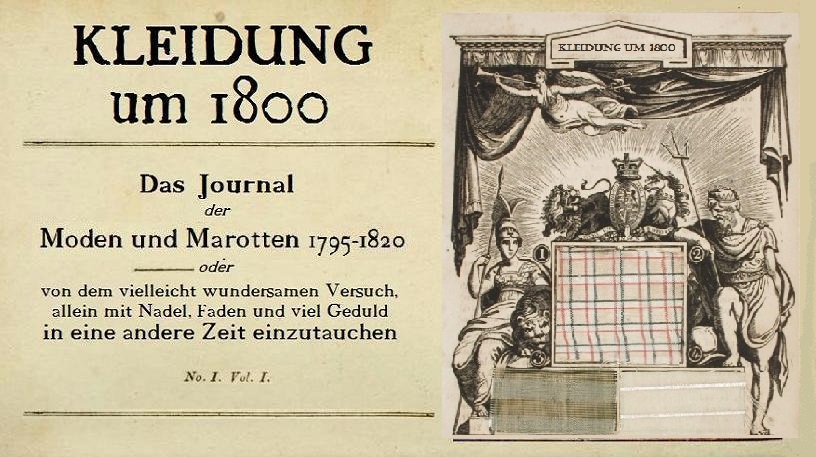Consulat? Biedermeier? Uff!!!
Wenn man sich mit der Kleidung und Lebensart von 1795
bis 1820 beschäftigt, gerät man unweigerlich immer wieder an
viele verschiedene Begriffe, welche diese Jahre
beschreiben.
Das kann mitunter, gerade zu Beginn, einige Verwirrung
stiften, denn einen einheitlichen Namen trägt der Zeitraum nicht.
Im Folgenden möchte ich ein paar geläufige Begriffe
(verschiedener Länder und Geisteswissenschaften) mit den dazugehörigen Daten
aufführen.
Consulat? Biedermeier? Whew!!!
When reading
about fashion and lifestyle from
1795 to 1820, there will inevitably
appear a whole lot of different terms, describing those years.
This can be kind of confusing, especially in
the beginning, as there’s no standard term for the time span.
Therefore I’d like to mention a few common
terms (from different countries and arts)
with specifications.
In Deutschland
begegnen wir in
diesem Zusammenhang vorrangig dem
Begriff des
Klassizismus (kunstgeschichtlich)
bzw der Klassik (literaturgeschichtlich) 1776 -
1832.
Letztere Bezeichnung begründet durch Johann
Wolfgang von Goethe und Friedrich Schiller.
Gleichzeitig treten die geistigen Strömungen der
Romantik (1798 – 1835, oft auch bis 1848) und des Biedermeier
(1815 -1848)
in Erscheinung.
Die Romantik teilt sich in folgende Abschnitte auf:
Frühromantik (1795/98 - 1804)
Hochromantik (1805 - 1814)
Spätromantik (1815 - 1835/bzw 1848)
in Erscheinung.
Die Romantik teilt sich in folgende Abschnitte auf:
Frühromantik (1795/98 - 1804)
Hochromantik (1805 - 1814)
Spätromantik (1815 - 1835/bzw 1848)
Politisch wird die Zeit auch als Napoleonische Zeit (1803-1815)
bezeichnet.
-
Diesen Begriff findet man auch in
Großbritannien
als Napoleonic Wars (1803 - 1815).
Jedoch wird die Epoche dort selbstverständlich anhand
der Regierungszeiten der britischen Könige beschrieben, in dem Fall George I,
George II, George III und George IV
(1714-1830): also Georgian Era.
Die vielzitierte
British Regency (1811 - 1820),
bezeichnet dabei die Zeit, in der George III aufgrund
von Krankheit nicht mehr regierungsfähig war und sein Sohn als Prince of Wales
(also als Prinzregent) die Geschäfte übernahm, bis er schließlich durch den Tod
des Vaters 1820 zum König George IV ernannt wurde.
-
Immer wieder taucht der Name „Napoleon“ auf, kaum
verwunderlich, dass die Epoche in Frankreich
vorrangig mit seiner Regieungszeit beschrieben wird:
Directoire (1795 - 1799)
Consulat (1799 - 1804)
Premier Empire (1804 - 1814)
-
Selbst in den USA
taucht der Begriff der Napoleonic Wars (1803 -
1815)
auf, jedoch wird die Zeit dort als
Federalist
Era (1789 –
1801)
beschrieben.
In Germany
the terms
Klassizismus (history of arts)
or Klassik ( history of literature) 1776
- 1832
are usually named in this context. The latter
being founded by the famous poets Johann Wolfgang von Goethe and Friedrich
Schiller.
The sub-periods
Romantik (1798 - 1835, often also dated to the year 1848) and Biedermeier (1815 - 1848)
also appear/co-exist during those years.
The era of Romantik is seperated in the follwing periods:
Frühromantik (1795/98 - 1804)
Hochromantik (1805 - 1814)
Spätromantik (1815 - 1835/or 1848)
The era of Romantik is seperated in the follwing periods:
Frühromantik (1795/98 - 1804)
Hochromantik (1805 - 1814)
Spätromantik (1815 - 1835/or 1848)
A politcal term used is Napoleonische Kriege
(1803 – 1815)
-
In Great
Britain
the term Napoleonic Wars (1803 - 1815)
is also often used.
But usually the time
is labelled according to the succession of the british monarchs, George I,
George II, George III and George IV
(1714 – 1830): the Georgian era.
The often mentioned
British Regency (1811 – 1820)
is defined by George as Prince of Wales
reigning during the illness of his father George III, until in 1820 the king
died and he succeeded as King George IV.
-
The name „Napoleon“ is ubiquitous during
those years, no wonder, that in
France
the era is named after his reign:
Directoire (1795 - 1799)
Consulat (1799 - 1804)
Premier Empire (1804 - 1814)
-
Even in the US
the term Napolonic Wars (1803 –
1815) is used, but usually the years from
1789 – 1801 are
named Federalist Era.
Übrigens: weitere Ergänzungen nehme ich gerne in diese
Liste auf.
Btw: I’d be happy to add further information to
this list.

Whew, Sabine! Thanks for putting all those dates in one place. It is rather confusing!
AntwortenLöschenQuinn
Thank you for this wonderful list of clarifications. I tend to fall into the habit of calling everything from 1790-1820 "regency" although, technically, I should be using other terms!
AntwortenLöschenI like the term "federalist" era, being from the US myself.
So many different names for the same styles of fashion!
I always have trouble figuring out what to call it. Here in America we mostly call this time period regency, despite the fact that we really should be calling it federalist. Then when I'm talking to my friends at home( Germany) I never know how to explain to them what exactly I do , when I tell them I make regency clothes they have no idea what I'm talking about if I call it Biedermeier they think of big poofy Sissi dresses... So I tend to call it Napoleonic when speaking to Europeans... such a dilemma
AntwortenLöschenDear Sabine,
AntwortenLöschenThank you for the analysis...good piece for referral.
Hugs,
Natalie